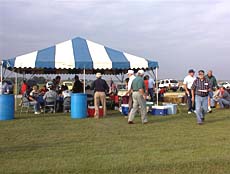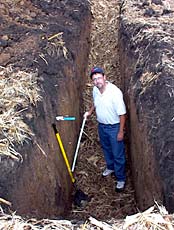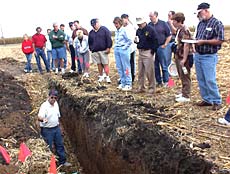|
Features,
Honors
& Awards, Ag
Announcements
Calendar,
Ag News Elsewhere
(fresh daily from the Web)
|
|
Features
|
|
First chamber-ag day a success
[SEPT. 17, 2002]
The first "Chamber Mixer on
the Farm" won’t be the last, according to Bobbi Abbott, director of
the Lincoln/Logan Chamber of Commerce. "It’s been such a success
that we hope to do it every year," she said.
|
|
About 75 people gathered Sunday
afternoon at the Jeff Elsas farm north of town to meet their
neighbors and learn how valuable farming is to the financial health
of Logan County. For example, commodities from the 729 farms in the
county bring in about $112 million in cash receipts each year.

[Photos by Joan Crabb]
Visitors also learned why Logan County
soils are so productive. Bill Dickerson, district conservationist
for Natural Resources Conservation Service, explained this as he
stood in an 8-foot-deep pit dug by a backhoe for the occasion.

The chance to see a slice of good Logan
County soil brought visitors to the edge of the pit. Dickerson
described the soil on Elsas’ farm as "the perfect balance for crop
production, as good a soil as you would find anywhere."
Sixteen inches of black topsoil sits on
top of a 4-foot layer of moderately well- to well-drained silty clay
loam that is "forgiving" enough to release water to plants and to
allow root systems to go deep, he explained. Below the clay loam is
a layer of sand.
The black organic matter came from
prairie grasses, which produced much more organic matter than
woodlands.
Called Tama silt loan, this soil was
deposited by wind after the last glacier, the Wisconsin, receded
about 15,000 years ago, according to scientists.

Mixer visitors also heard a
presentation by David Ramsey of the Land of Lincoln Agriculture
Coalition about the possibility of building a farmer-owned ethanol
plant in Elkhart.
Ramsey said if it becomes possible to
use the waste coal from the Turris mine, the proposed plant could be
one of the lowest-cost producers in the area. Turris is working on
ways to clean up high-sulfur Illinois coal so it can meet
Environmental Protection Agency standards.
Ramsey said the proposed plant would
use only the starch and sugar in corn to make the ethanol, so the
portion of the grain left would contain protein and be suitable for
animal feed.
Of every 10 gallons of gasoline
American drivers use, five gallons come from imported oil, four come
from domestic oil, which is environmentally costly to produce, and
one gallon comes from ethanol. That one gallon of ethanol would be
renewable every year, unlike the other nine gallons in the tank, he
said.
[to top of second column in
this article]
|

As other gasoline additives that reduce
vehicle emissions are being phased out, the demand for ethanol will
rise from the 2.4 billion gallons now in use to three billion
gallons, perhaps as high as 5.5 billion gallons within 10 years.
The proposed Elkhart plant would cost
$75 million and require about 1,000 farmer-landowner investors. It
would create 41 permanent jobs at the plant along with another 700
jobs for others, such as truckers hauling its products, he said.
The Land of Lincoln Agriculture
Coalition is a "think tank" of farmers and agribusiness people that
for the past two years has been trying to find ways to add value to
agriculture, according to Ramsey.
A highlight of the day for about 15 of
the visitors was a ride on Elsas’ eight-row John Deere combine as it
took a turn around the field. Some saw for the first time a combine
turning rows of standing corn into wagons full of golden kernels.
Elizabeth Murray Collins, almost 8
years old, was impressed with the demonstration.
"I’ve never been on anything that big
before," she said.
While demonstrating the combine, Elsas
also got most of a 30-acre stand of corn harvested, said his farming
partner Steve Haseley. Haseley said Elsas was getting about 180-185
bushels to the acre, with about 20 percent moisture content.

The harvested corn was trucked to the
East Lincoln elevator, which Hugh Whalen opened especially to
accommodate Elsas and the chamber mixer, Haseley said.
Bill Sahs of Lincoln was coordinator of
the event, and Larry Huelskoetter, chairman of the chamber’s ag
awareness subcommittee, served as master of ceremonies.
Farm equipment from Atlanta Ag Center
and Central Illinois Ag, also of Atlanta, was on the grounds for
visitors to see.
Marty Ahrends, co-chairman of the
chamber’s ag committee, said the chamber appreciated the cooperation
of Elsas and Haseley for the event.
"The ag committee and other producers
in Logan County are going to do a value-added agriculture visioning
process this winter to identify strengths and weaknesses and look
for opportunities to add value to the agricultural operation and to
the commodities they produce," she said.
Abbott said
she believes it is very important to make connections between
business people and ag producers. "I think we have made a good start
with this event," she said.
[Joan
Crabb]
|
|
Want your ad to be
seen all over Logan County?
Advertise with
Lincoln Daily News!
Call (217)
732-7443
or e-mail
ads@lincolndailynews.com |
Our staff offers more than 25 years of experience in the
automotive industry.
Greyhound
Lube
At the corner of Woodlawn and Business 55
No Appointments
Necessary |
Lincolndailynews.com
is the place to
advertise
Call (217) 732-7443
or e-mail
ads@lincolndailynews.com |
|
|
|
Weekly outlook
September reports
[SEPT.
17, 2002]
URBANA — The relatively high
level of prices, the lack of carry in the corn and soybean price
structure, and the absence of loan deficiency payments all favor
harvest sales of corn and soybeans, said a University of Illinois
Extension marketing specialist.
|
|
"However, the tightness in the balance
sheets, the uncertainty about the South American growing season and
the need for large crops in the Northern Hemisphere next year
suggest that some ownership should be maintained into the winter and
spring months," said Darrel Good.
"Speculating on higher prices by
storing the crops is relatively expensive. Basis contracts or
ownership of futures may be less expensive, but not all producers
are willing to use these tools. The Commodity Credit Corporation
loan provides cash flow for those who choose to store part of the
crop."
Good’s comments came as he reviewed the
USDA’s September reports. The report of U.S. and world crop
prospects contained no major surprises. At 8.849 billion bushels,
the U.S. corn crop projection was 37 million bushels smaller than
the August projection, even though the U.S. average yield estimate
was increased by 0.2 bushels, to 125.4 bushels. Stocks of U.S. corn
at the end of the 2002-03 marketing year are expected to be a meager
729 million bushels, the lowest level in seven years.
Compared to the year just ended, the
USDA projects a 225-million-bushel reduction in feed and residual
use of corn during the current marketing year, a 115-million-bushel
increase in domestic processing use of corn, and a
100-million-bushel increase in U.S. exports.

"Few doubt that processing use of corn
will increase, due to expanded ethanol capacity," said Good.
"Opinions differ on prospective feeding and exports of U.S. corn.
The projected decline in feed use will have to come as the result of
fewer animals or a decline in the amount of grain fed per animal
since the decline in corn consumption is not expected to be offset
by increased feeding of other grains.
"The USDA’s Dec. 1 Grain Stocks report,
to be released in early January, will reveal the rate of domestic
feed and residual use of corn during the first quarter of the
2002-03 marketing year. That report will be important in determining
if corn prices are generating the necessary adjustments in use."
Good added that the projected increase
in U.S. corn exports reflects expectations of a small increase in
world consumption and a decline in exports from Argentina. Chinese
exports are expected to increase by 59 million bushels (19 percent)
due to a 433-million-bushel (10 percent) increase in production. As
of Sept. 5, 244 million bushels of U.S. corn had been sold for
export during the current marketing year, 17 million less than sales
of a year ago.
"The market will continue to monitor
weekly sales and export reports, as well as the sales of Chinese
corn, for clues as to the accuracy of the USDA projection," said
Good.
[to top of second column in
this article]
|

At 2.656 billion bushels, the USDA’s
September projection of the U.S. soybean crop was 28 million bushels
larger than the August projection. A small reduction in the
projection of harvested acreage was more than offset by an increase
in the expected yield. The U.S. average yield is now projected at 37
bushels per acre, 0.5 bushels above the August projection but 2.6
bushels below the 2001 average yield.
For the current U.S. marketing year,
the USDA projects a 215-million-bushel (20 percent) decline in
exports and a 25-million-bushel (1.5 percent) decline in the
domestic crush.
"The decline in consumption is being
required by the smaller crop," said Good. "Year-ending stocks are
expected to total only 160 million bushels, the lowest level in six
years. Part of the reduction will be accomplished through higher
prices, but much of the cut in U.S. exports is expected to be offset
by larger South American exports.
"For the year October 2002 through
September 2003, the USDA expects South American exports to total
1.25 billion bushels, 367 million bushels more than exported in the
previous 12 months. The larger projection reflects the large 2002
South American crop, an expected 8.7 percent increase in production
in 2003 and continued expansion in world soybean consumption."
As of Sept. 5, export sales of U.S.
soybeans totaled 213 million bushels, 4.5 million larger than sales
of a year ago. The market will continue to pay close attention to
the rate of U.S. soybean export sales and the development of the
South American crop.
Corn and soybean prices moved higher
prior to the release of the USDA’s report on Sept. 12. The lack of
surprises in the report and the start of the Midwest harvest allowed
December corn futures to decline about 20 cents and November soybean
futures to decline about 30 cents following the release of the
reports.

"In addition to the ongoing reports on
the rate of consumption, the market will react to yield reports over
the next several weeks," said Good. "Given the expected drawdown in
U.S. and world inventories, small changes in expected crop size
could have important price implications.
"Those small
inventories also mean that prices could be very sensitive to 2003-04
production prospects."
[U
of I news release]
|
|
 |
|
|
Learn
more about global food security
[SEPT.
14, 2002]
URBANA — Food safety and
security is the theme of a series of free public lectures to be
presented at the University of Illinois this fall. William Masters,
professor of agricultural economics at Purdue University, will be
the featured speaker from 4 to 5 p.m. on Thursday, Oct. 3, in the
ACES Library, Information and Alumni Center.
|
|
Masters has done research on food
production, policy and trade in Africa and around the world. The
title of his talk will be "Institutions and Technology for Food
Security: Peril and Progress."
"America has traditionally viewed food
security as a problem of the developing world, but no more," said
Steven Pueppke, associate dean of the College of Agricultural,
Consumer and Environmental Sciences at U of I. "One of the many
lessons of Sept. 11 is that food security is a global challenge from
which no nation is exempt."
Because of this new, heightened
awareness about food safety and security, Pueppke said that
America’s Land Grant universities, including the U of I’s College of
ACES, are vitally interested in the complexity of global food
production and movement. "This system," Pueppke said, "affects not
only the welfare of millions of people, but also our markets, our
international policies and the security of our own food supply."
Masters said that there is abundant
food available in most of the world, but Africa and South Asia still
suffer from widespread malnutrition.
"For decades, poverty in these regions
was linked to social institutions and policy choices," said Masters.
"Those policies are now changing, and there is a critical need for
appropriate new technologies. Without government-funded research and
development, no amount of market reform will give farmers the right
kinds of seeds — or new medicines for tropical diseases."
[to top of second column in
this article]
|
Masters’ research points to the key
role of science-based innovation in the global economy and the large
payoffs from investing in public-sector research and development on
tropical agriculture and public health. But Masters admits that
building political support for this may be particularly difficult
now because of the relative abundance of food elsewhere in the
world.
ACES Library, Information and Alumni
Center is located near the south end of the University of Illinois
campus. From Pennsylvania Avenue, turn north to the octagonal
library building. Metered parking is available on surrounding
streets.
The seminar, part of a series of public
lectures on global food security, is sponsored in part by ACES
Global Connect, the international arm of the College of Agricultural
Consumer and Environmental Sciences at the University of Illinois.
The final lecture in the series will feature Werner Kiene,
representative of the United Nations World Food Programme to the
Bretton Woods Institutions, and will be from 4 to 5 p.m. on
Thursday, Nov. 7.
For more
information visit
http://www.aces.uiuc.edu/global/seminar.
[U of I news release] |
|
|
Electrical safety during harvest
Watch for overhead power lines, other
electrical hazards
during harvest season
[SEPT.
12, 2002]
URBANA — Dozens of farm
workers are killed by electrocution each year when their farm
machines and equipment make contact with overhead power lines. These
tragic accidents are preventable.
|
|
With harvest season getting under way,
the Safe Electricity program urges farm workers to take note of
electrical lines when moving equipment such as portable grain
augers, oversized wagons and large combines, and to use a qualified
electrician for electrical system repairs.
"The rush to harvest can cause farm
workers to skip important safety steps," said Molly Hall, director
of Safe Electricity. "Tragic deaths and injuries can be avoided if
precautions are taken, like making sure everyone who works on the
farm knows the location of power lines and keeps farm equipment at
least 10 feet away from them."
"Equipment contacting overhead power
lines is the leading cause of farm electrocution accidents in the
Midwest," said Bob Aherin, University of Illinois agricultural
safety specialist. "Moving portable grain augers poses the greatest
risk because those who are [on] the ground moving the equipment
would provide a direct path for electricity if there’s a contact
with overhead wires."
"Always lower grain augers before
moving them, even if it’s only a few feet. Variables like wind,
uneven ground, shifting weight or other conditions can combine to
create an unexpected result," Aherin said.
Farm workers also are advised not to
use metal poles when breaking up bridged grain inside and around
bins and to use qualified electricians for work on drying equipment
and other farm electrical systems.
"It’s also important for operators of
farm equipment or vehicles to know what to do if the vehicle comes
in contact with a power line," Hall said. "It’s almost always best
to stay in the cab, call for help and wait until the electric
utility arrives to make sure power to the line is cut off."
[to top of second column in this
article]
|
"If the power line is energized and you
step outside, your body becomes the path and electrocution is the
result," Aherin said. "Even if a power line has landed on the
ground, there is still the potential for the area nearby to be
energized. Stay inside the vehicle unless there’s fire or imminent
risk of fire."
In that case, the proper action is to
jump — not step — with both feet hitting the ground at the same
time. Jump clear, without touching the vehicle and ground at the
same time and continue to shuffle or hop to safety, keeping both
feet together, as you leave the area.
"Like the ripples in a pond or lake,
the voltage diminishes the farther out it is from the source,"
Aherin said. "Stepping from one voltage level to another allows the
body to become a path for that electricity. A large difference in
voltage between both feet could kill you.
"Be sure that at no time you or anyone
touches the equipment and the ground at the same time. Never should
the operator simply step out of the vehicle — the person must jump
clear."
Prevention of electricity-related
tragedies is the goal of Safe Electricity, a statewide program
created by a coalition of nearly three dozen organizations,
including Illinois investor-owned electric utilities, electric
cooperatives and the University of Illinois. All are members of the
Illinois Electric Council, a nonprofit industry forum, which
launched the safety awareness program last year.
In addition
to public service announcements and other outreach efforts, Safe
Electricity has an online electrical safety center,
www.SafeElectricity.org.
The section on agribusiness provides tips and detailed information
for farm workers. Residential safety, contractor safety, teacher
resources, and youth games and activities can also be found at this
site on the Web.
[U of I news release] |
|
|
FFA
officers attend conference
[SEPT.
12, 2002]
The Section 14 officer team
attended the District III STAR Conference at John Wood Community
College in Perry on Sept. 4. The conference covered many aspects of
the FFA, with the goal of giving the officers more information to
help promote agricultural education and the FFA.
|
|
Working with the Illinois FFA state
vice president, Rebecca Yandell, and the state treasurer, Meagan
Wells, the Section 14 officers learned about communicating, their
true colors, the FFA programs, as well as many applications and
other teamwork and leadership skills.
Many goals were set and activities
planned at the conference, in hope of helping "Excellence Become
Tradition" this year.
[FFA
news
release] |

[Photo provided by FFA]
Section 14
officers are pictured at the District III Star Conference. From left
to right are Rebecca Yandell, state VP; Meagan Wells, state
treasurer; Bruce Frank, president; Amanda Davison, VP; Natalie Coers,
reporter; Emily Bakken, secretary; KC Fritzsche, treasurer; and
Jeffrey Evers, sentinel.
|
|
|
Section
14 FFA reporters attend workshop
[SEPT.
12, 2002]
On Sept. 3, FFA reporters
from Section 14 attended the Illinois FFA Reporter’s Workshop at
Lincoln Land Community College in Springfield.
|
|
At this workshop, presented by the
Illinois FFA state reporter, Emilee Bocker, chapter reporters were
instructed and motivated to report FFA news promptly and
efficiently. The reporters also had an opportunity to exchange ideas
with other reporters and ask questions about their duties for the
upcoming year.
The FFA
strives to live by its motto: "Learning to Do, Doing to Learn;
Earning to Live, Living to Serve."
[FFA
news
release] |

Section 14
FFA Members (pictured) from Williamsville, Athens, Greenview,
Lincoln and Hartsburg-Emden attended the workshop, presented by
Emilee Bocker, the State FFA Reporter.
|
|
|
When is it fall?
[SEPT.
9, 2002]
Fall doesn’t officially
start for another week and a half or so, but several of the signs
tell us that fall is here. We have had some geese flying south, the
woolly bear caterpillars are crossing the road, the cicadas have
been singing for six weeks now, and the combines are starting to
pick around in some cornfields. Fall is when harvest comes about in
my mind.
|
|
Now the producers out with the combines
are looking for a patch of drier corn to start on, taking out some
corn that has blown flat in a windstorm or is at high risk for going
flat or losing ears from European corn borer damage.
Let’s face it. Most people wouldn’t
want to give away much of their product value in drying costs. Corn
is still valued at "mediocre" values, around $2.50 per bushel. Most
commercial elevators are charging about 2 cents per bushel per point
of moisture. With 30 percent moisture corn needing to be dried to 15
percent moisture for fall sale, this means 30 cents per bushel
drying charges.
The kicker is finding the happy medium,
when corn is easily harvested (standing up) and ears are not falling
off the plants, along with finding a drying cost you can live with.
Most producers like to wait to get started until corn is around 20
percent to 24 percent, and by the time they finish, the corn may be
down in the 17 percent range. It makes the cost a little more
bearable.

Fall traffic will greatly increase on
rural roads as harvesting starts and hauling machinery begins to
move. Keep your eyes open because large, slow-moving machinery can
be a recipe for disaster for the unaware. Farmers need to make sure
they use the lights and slow-moving vehicle signs on equipment to
help other drivers recognize farm machinery from a distance. Be
aware and have a safe fall.
[to top of second column in
this article]
|
Farm program
computer analysis
There are several farm program computer
analysis programs available online. These include programs offered
by the Texas A&M site, the Iowa State/University of Illinois site,
the Corn Growers Association and the Farm Bureau, among others. That
is all well and good if you have some time, a good computer
connection and understand the information needed to plug into the
formulas. If not, there is an upcoming opportunity for you.
Terry Griffin, Extension educator in
farm business management, will be in the Logan County Extension
office on Sept. 17 from 1 to 3 p.m. with his mobile computer lab.
This will allow producers to input information in the University of
Illinois program to determine the "best" option to use when signing
up for the farm program.
Interested
individuals should pick up or request worksheets to complete before
the workshop. There will be approximately 10 computers available
that day. If you would like to make a reservation, call the office
at 732-8289 to book half-hour time blocks for computer usage.
[John
Fulton]
|
|
|
Honors
& Awards
|
|
|
Ag
Announcements
|
|